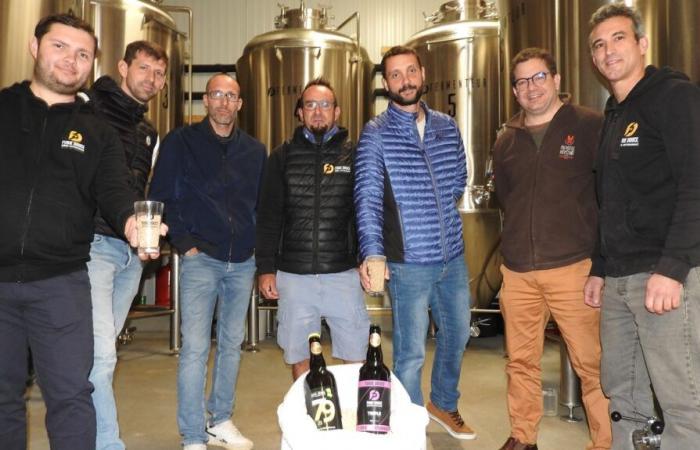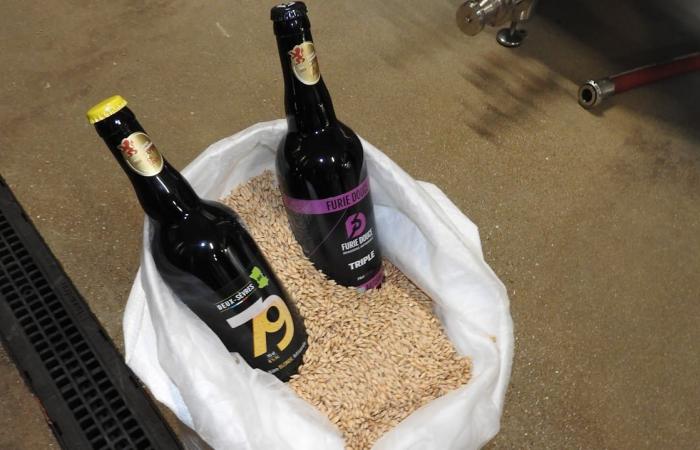Created in 2021 by Julien Bertrand, Pascal Sage and Sébastien Boutet, La Furie Douce beer has its birthplace in Clessé. Over the last three years, it has conquered local palates and the three partners produce 80,000 liters of ten varieties of beer, including a handful under the slightly cocardière 79 brand.
Probably not cheerful enough since the three partners will brew their beer for the first time this year under the Product des Deux-Sèvres brand. “To meet the specifications of this brand created by the Department, 50% of the raw materials must come from Deux-Sèvresexplains Julien Bertrand. There, we are at more than 80%. »
Each year, 15 tonnes of malt pass through the Furie Doux vats and produce 80,000 liters of ten types of beers.
© Photo NR, Dominique Guinefoleau
To make beer, everything starts from malt, itself made from barley. This brewing quality barley is germinated and its germination process is stopped by cooking which sets the process of transformation of the starch into fermentable sugars which will give, when brewing with yeasts, the alcohol, the taste and the character of the beer.
“A beer is 99% water and malt”summarizes Vincent Feix, the co-founder of Malterie de l'Ouest (Bernay-Saint-Martin, Charente-Maritime) which supplies their malt to the Clessean partners. “But water does not count in the specifications of the Product des Deux-Sèvres brand which only takes dry matter into account”specifies Julien Bertrand.
From field to bottle
Until now, La Furie Douce beers were produced from 100% Poitou-Charentes barley, but the three brewing partners wanted to push the envelope a little further by sourcing from their department. And they joined forces to do this with the Gaec des Trois Horizons of Benjamin Guignard, Stéphane Bourdeau and Pierre-Luc Sauvêtre, in Saint-Aubin-le-Cloud.
“In fact, we could have brewed last year from their barley, but that could not be done because their production was not sufficient”explains Julien Bertrand. This agricultural hazard did not prevent brewers and growers from successfully continuing on this path this year.
Even before the creation of the Product des Deux-Sèvres brand, the partners of Furie Douce released a 79 beer.
© Photo NR, Dominique Guinefoleau
The three farmers, who usually deliver their malting barley in a cooperative, reserved 10 tonnes last October for Malterie de l'Ouest. “It takes 250 g of malt to produce 1 liter of beerexplains Julien Bertrand. We consume 15 tonnes of barley per year but the industrial facilities at Malterie de l'Ouest are designed to produce malt in batches of 10 tonnes. »
Not necessarily annoying since this malt serves as the basis for the Sweet Fury recipes. “In fact, this malt produced from Gaec des Trois Horizons barley serves as the basis for our beer and gives its alcoholexplains Sébastien Boutet. Other more or less roasted malts and other ingredients are added to obtain different types and aromas of beer. »
There is total traceability from the field to the bottle
Vincent Feix, co-founder of Malterie de l’Ouest Clessé
Simple on paper but you still need to be able to guarantee that the Deux-Sévrienne barley is indeed the one supplied to the Clessée brewery. A guarantee obtained by Malterie de l'Ouest by dedicating a production batch to the transformation of 10 tonnes of barley from Gaec des Trois Horizons into as much malt for Furie Douce. “There is total traceability from the field to the bottle”assures Vincent Feix.
“It’s a financial effortsays Julien Bertrand. This could only be done because the partners of Gaec des Trois Horizons, Malterie de l'Ouest and we are aware of a short circuit approach. » No doubt because Soft Fury customers are also sensitive to this argument. “When we deliver to the cooperative, we don’t know where our barley is going. We were already doing direct sales and it’s rewarding to know where our barley is going”confirm the three farmers.
See and taste what the seven beer lovers are eager to check out. In cervisia veritas.







